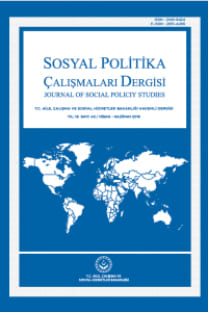2012 TÜRKİYE SAĞLIK ARAŞTIRMASI’NIN ENGELLİLİĞE İLİŞKİN YAYGINLIK ÖLÇÜMÜ AÇISINDAN İNCELENMESİ
Çok boyutlu bir olgu olan engelliliğe ilişkin yaygınlığın ölçülmesinde pek çok yöntem kullanılmaktadır. Ancak engelliliğe ilişkin yaygınlığın ölçümünde, verinin hangi amaçla toplanacağı hususu kullanılacak ölçümün yönteminin belirlenmesinde genellikle belirleyici olmaktadır. Örneğin hizmet sunumu, nüfusun işlevsellik düzeyinin ölçümü veya engelli bireylerin sosyal hayata katılım düzeylerini değerlendirme gibi amaçlarla toplanacak veriler ölçüm yöntemiyle doğrudan ilişkilidir. Bu çalışmada bireylerin işlevselliklerine odaklanan, kısa soru setini geliştiren Washington Engellilik İstatistikleri Grubu’nun çalışmaları değerlendirilmiş ve 2012 yılında Türkiye’de gerçekleştirilen sağlık araştırmasında yer alan soru seti, farklı sonuçlar elde etmek amacıyla incelenmiştir. Türkiye’de bireylerin genel sağlık durumunu ortaya koyan “Türkiye Sağlık Araştırması” soru formunda, bireylerin belirli işlevleri yerine getirme düzeylerini ölçen soru setine yer verilmiştir. Washington Engellilik İstatistikleri Grubu’nun (WG) bir çalışması olan bu soru seti, engelliliği işlevsellik yaklaşımıyla bağdaştırmakta ve engellilik istatistiklerinin toplanma amaçlarıyla uyumlu bir şekilde esneklik sağlamaktadır.
Anahtar Kelimeler:
Engellilik, engelliliğe ilişkin yaygınlık, işlevsellik yaklaşımı, Türkiye Sağlık Araştırması, Washington Engellilik İstatistikleri Grubu
ANALYZE OF TURKEY HEALTH SURVEY 2012 IN TERMS OF MEASUREMENT OF DISABILITY PREVALENCE
Many methods are utilized in prevalence measurement of disability as a multidimensional concept. However, the purpose of the measurement can shape the method to be preferred. For instance, the datum to be gathered with purposes such as service provision, measurement of functionality level of the population, and/or assessment of the level of social participation for PwD’s is directly linked with the method of measurement. This study reviews the reports of Washington Group on Disability Statistics and analyses the question set in Health Survey 2012 with the aim of producing various results. A question set measuring the individual level of fulfilling various functions was also included in the question form of Health Survey 2012. This question set that was prepared by Washington Group on Disability Statistics (WG) assesses disability in terms of functionality approach and it provides flexibility in line with the purposes of data collection on disability.
Keywords:
Disability, disability prevalence, functional approaches, Health Survey of Turkey, Washington Group on Disability Statistics,
___
- Altman, B. M. (2001). Disability definations, models, classification schemes and
- applications. G.L. Albrecht, K. Seelman ve M. Bury (Ed.), Handbook of Disability
- Study (ss. 97-122). London: Sage Publications Inc.
- Başol, K. (1984). Demografi: Genel ve Türkiye. İzmir: Dokuz Eylül Üniversitesi İktisadi ve
- İdari Bilimler Fakültesi Yayınları.
- Cillov, H. (1960). Nüfus istatistikleri ve demografinin genel esasları. İstanbul: İstanbul
- Üniversitesi İktisat Fakültesi Yayınları.
- Devlet İstatistik Enstitüsü. (2001). 2000 Genel nüfus sayımı: Nüfusun sosyal ve ekonomik
- nitelikleri. Ankara: Devlet İstatistik Enstitüsü Matbaası.
- Devlet İstatistik Enstitüsü/Özürlüler İdaresi Başkanlığı. (2009). Türkiye Özürlüler
- Araştırması 2002 (İkinci baskı). Ankara: Devlet İstatistik Enstitüsü Matbaası.
- Eide, A. H. ve Loeb, M. E. (2005). Data and statistics on disability in developing countries.
- Erişim Tarihi: 26.01.2016, http://r4d.dfid.gov.uk/pdf/outputs/disability/thematic_
- stats.pdf.
- Ekenci, M. (2014). Engelli bireylere ilişkin resmi veri toplama araçlarının ulusal düzeyde
- yaygınlık tahminlerinde kullanımı (Yayımlanmamış Uzmanlık Tezi). Aile ve Sosyal
- Politikalar Bakanlığı, Ankara.
- Hughes, B. ve Paterson, K. (1997). he social model of disability and the disappearing
- body: Towards a sociology of impairment. Disability and Society, 12(3), ss. 325-340.
- International Labour Organization. (2007). he employment situation of people with
- disabilities: Towards improved statistical information. France: International Labour
- Organization.
- Loeb, M. E., Eide, A. H. ve Mont, D. (2008). Approaching the measurement of disability
- prevalence: he case of Zambia. Alter European Journal of Disability Research, 2(1),
- ss. 32-43.
- Mont, D. (2007). Measuring disability prevalence (Social Protection Discussion Paper No.
- . Washington: World Bank.
- National Center for Health Statistics. (2009). Washington Group on Disability Statistics.
- Centers for Disease Control and Prevention.
- Shakespeare, T. ve Watson, N. (1997). Defending the social model. Disability and Society,
- (2), ss. 293-300.
- Türkiye İstatistik Kurumu. (2013a). Sağlık Araştırması 2012. Ankara: Türkiye İstatistik
- Kurumu Matbaası.
- Türkiye İstatistik Kurumu (2013b). Türkiye Sağlık Araştırması Mikro Veri Seti 2012.
- Ankara: Türkiye İstatistik Kurumu Matbaası.
- Türkiye İstatistik Kurumu (2013c). Nüfus ve konut araştırması 2011. Ankara: Türkiye
- İstatistik Kurumu Matbaası.
- United Nations. (2006). Convention on the rights of persons with disabilities. New York:
- United Nations.
- United Nations Statistics Division [UNSD]. (2001). Guidelines and principles for the
- development of disability statistics (Statistics on Special Population Groups, Series Y,
- No. 10). New York: United Nations.
- United Nations Statistics Division [UNSD]. (2003). he collection and dissemination
- of statistics on disability at the United Nations Statistics Division: Proposals for the
- future. New York: United Nations.
- United Nations Washingon Group on Disability Statistics [WG]. (2004). Proposed
- purpose of an internationally comparable general disability measure (Washington
- Group Position Paper). Erişim tarihi: 26.01.2016, http://www.cdc.gov/nchs/data/
- washington_group/meeting3/WG_purpose_paper.pdf.
- United Nations Washingon Group on Disability Statistics [WG]. (2009). Understanding
- and Interpreting Disability as Measured Using the WG Short Set of Question.
- Washington Group Position Paper.
- World Health Organization. (2001). International classification of functioning and disability
- and health (ICF). Switzerland, Genava: WHO.
- World Health Organization/ World Bank. (2011). World report on disability. Malta: WHO.
- ISSN: 2148-9424
- Yayın Aralığı: Yılda 4 Sayı
- Başlangıç: 2012
- Yayıncı: Aile,Çalışma ve Sosyal Hizmetler Bakanlığı
Sayıdaki Diğer Makaleler
2012 TÜRKİYE SAĞLIK ARAŞTIRMASI’NIN ENGELLİLİĞE İLİŞKİN YAYGINLIK ÖLÇÜMÜ AÇISINDAN İNCELENMESİ
Miguel Ángel GARCÍA OCA, Natacha LEÓN ÁLVAREZ, Luis JAÉN CAPARRÓS
ENGELLİLERDE SPORTİF BECERİ VE KOORDİNASYON EĞİTİM PROGRAMLARI
Doç. Dr. Yaşar TATAR, Doç. Dr. Selda UZUN, Doç. Dr. Nusret RAMAZANOĞLU
ENGELLİLERE YÖNELİK ÜLKEMİZDEKİ ÖZEL EĞİTİM HİZMET UYGULAMALARI VE ÖRNEK ÜLKE KARŞILAŞTIRMASI
Yrd. Doç. Dr. Serdar ORHAN, Kemal Gökmen GENÇ
